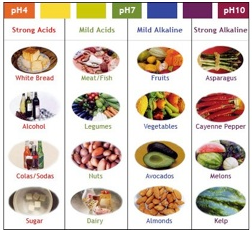
Acid and alkaline refers to the ph of the mineral breakdown of foods once they enter the bloodstream after digestion. A diet which is predominantly alkaline protects the body from inflammatory conditions such as arthritis, as well as general stiffness of the joints. As the ph of the blood is slightly alkaline, it makes sense to eat an alkaline diet. A good guideline is 70% alkaline foods and 30 % acid.
Drink your milk has been a common adage to build healthy bones. Is this really right for you? Milk actually contributes to an acidic environment in the body, and acidic environments in the body actually create weak bones and create an optimal environment for disease research tells us.
“How does it do this?,” you might ask. Essentially, our blood needs to remain at a certain pH; otherwise, it will cause problems in the body. That pH is slightly alkaline and right around 7.36. The problem is that most foods in standard diets are acidic, and this means that people become acidic from consuming these foods.
Commonly consumed, highly acidic foods include meat, dairy (including milk), processed foods, soft drinks, and sugared snacks; these are the worst offenders for creating acidic people.
Raw fruit and vegetables are alkaline forming in the body; they have an effect that raises our pH to a more alkaline state. But most people eat way too much on the first list, and much too little of what’s on the second list, and they do this for years on end.
When the blood starts to become acidic, the body needs to adjust.
To adjust to a more alkaline state, the body pulls the alkaline mineral calcium from your bones. By robbing calcium from your bones, your pH can become more alkaline which helps with your body’s immediate problem, but for your bones, it creates longer term problems.
In addition, numerous health problems are associated with having an acidic diet and body.
Robert O. Young tells us in The pH Miracle, that just about all health problems stem from being acidic. This is because parasites, bad bacteria, viruses, and candida overgrowth – all of which are the root causes of what we give thousands of disease names – thrive in acidic environments. But those problems don’t do well in an alkaline environment.
In fact, it’s been found that cancer doesn’t do well in an alkaline environment, and is most often found in bodies with a pH around 4 or 5, which is highly acidic. The fact that forty percent of the population is expected to have a problem with cancer is very telling about the acidic nature of people these days, and the problems with our standard diets.
Soft drinks, just so you know, have a pH of between 2.4 and 4.
On the pH scale 7 is neutral, and anything above 7 is alkaline; anything below 7 is acidic. pH is essentially a measure of the oxygen to hydrogen; substances and bodies with more oxygen than hydrogen will be on the alkaline side; whereas, those with more hydrogen than oxygen fall on the acidic side. Pesticides and chemicals in our foods and environment are also acidic.
Dealing specifically with the bones, the robbing of calcium means weak bones are created over time. We regularly see this in our culture as after about 50 or 60 years of acidic dietary habits, bones break easily and osteoporosis is common. These are exactly the problems you’d expect to see after years of consuming a diet that’s dominantly acidic, and they are exactly what we do see.
If you’re wondering where to get your calcium, now that you know that milk isn’t helping your bones, the answer is green leafy vegetables. Green leafy vegetables provide an abundant source of calcium that is bio-available, meaning that it’s easy for your body to absorb. The calcium in milk wasn’t very easy for your body to absorb anyway.
References:
Sources for this article include:
The ph Miracle, Robert O. Young, Ph. D
http://www.naturalnews.com…
http://articles.latimes.com/2005/mal…
http://www.examiner.com/x-7160-Sacrl…
http://www.advancedhealthplan.com/fl…
http://www.angelfire.com/az/sthurst…l
http://www.ameinfo.com/26590.htmll
About the author:
Kim Evans is a natural health writer and author of ‘Cleaning Up! The Ultimate Body Cleanse.’
Contact Us
Simply leave your information and one of our friendly staff members will contact you as soon as possible to discuss your needs.
Acid and Alkaline forming foods
Acid and alkaline refers to the ph of the mineral breakdown of foods once they enter the bloodstream after digestion. A diet which is predominantly alkaline protects the body from inflammatory conditions such as arthritis, as well as general stiffness of the joints. As the ph of the blood is slightly alkaline, it makes sense to eat an alkaline diet. A good guideline is 70% alkaline foods and 30 % acid.
Alkaline Forming Foods (70% of dietary intake)
| Almonds | Alfalfa | Apples |
| Apricots | Asparagus | Avocado |
| Artichokes | Beetroot | Broccoli |
| Bananas | Broth (vege) | Cabbage (red and white) |
| Carrots | Cauliflower | Celery |
| Cherries | Chicory | Coconut |
| Corn | Cucumber | Currants |
| Cantaloupe | Cranberries | Dates |
| Eggplant | Figs | Goats milk |
| Grapes | Grapefruit | Grape juice |
| Horseradish | Juice (vege) | Kelp |
| Kale | Kidney beans | Leek |
| Lemons | Lettuce | Lima beans |
| Millet | Mushrooms | Okra |
| Olives (ripe) | Onions | Olive oil |
| Oranges | Parsley | Parsnip |
| Pawpaw | Peaches | Pears |
| Peas (fresh) | Pineapple | Prunes |
| Pumpkin | Radish | Raisins |
| Rockmelon | Raspberries | Sorrel |
| Spinach | Squash | Sprouts (all types) |
| Strawberries | Soybeans | Sultanas |
| Swiss chard | Tomatoes | Turnip |
| Watercress | Watermelon | Zucchini |
EFFECTIVE RESULTS IN AS LITTLE AS ONE TREATMENT
